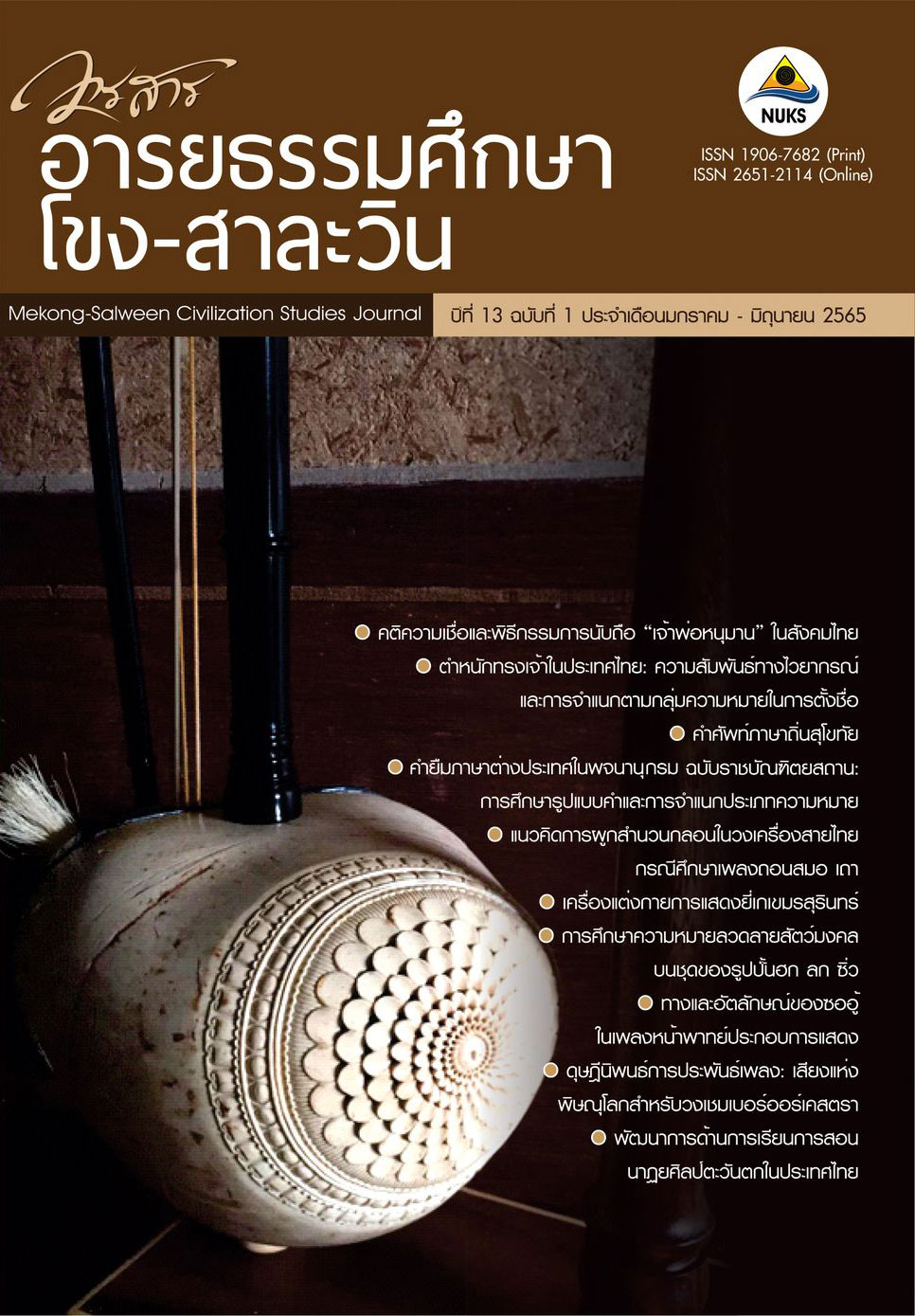Spirit Medium’s House in Thailand: Grammatical Relations and Classification according to Semantics Field in Naming ตำหนักทรงเจ้าในประเทศไทย: ความสัมพันธ์ทางไวยากรณ์และการจำแนกตามกลุ่มความหมายในการตั้งชื่อ
Main Article Content
Abstract
Spirit mediumship is a belief that has been associated with Thai society for a long time. In 2021, there are 108 spirit medium’s houses in Thailand. These spirit medium’s houses have different and unique names. This research aimed to study the grammatical relations and classification according to semantics field in naming of the spirit medium’s houses in Thailand. The data of 108 spirit medium’s houses were collected from Google Maps. The results of the analysis of grammatical relations revealed that the names of 27 spirit medium’s houses had a general structure, accounted for 25.00% of the total name lists. The syntactic hierarchy of complexity between the head nouns and the noun modifiers ranged from 2-4 syntactic hierarchies, in descending order as follows: 52 names with 2-syntactic hierarchy of complexity (48.15%); 22 names with 3-syntactic hierarchy of complexity (20.37%), 7 names with 4-syntactic hierarchy of complexity (6.48%). When the semantics field was classified, it was found that the head nouns consisted of kinship terms the most, showing the relationships among the sacred things and the owners of the spirit medium’s house and the people having faith in them. The noun modifiers contained the names of sacred things the most and had a more complex structure than those in the head nouns. This indicated that the noun modifier is the part that identifies or reveals the identity of sacred things as well as expressing their power or charisma. Therefore, it points out that although Thai society has Buddhism as the main religion, there are beliefs and faiths in the sacred things in “Brahmin-Hindu” and “sprit” cults, traditional beliefs that perfectly go together in Thai people’s way of life.
Downloads
Article Details

This work is licensed under a Creative Commons Attribution-NonCommercial-NoDerivatives 4.0 International License.
References
Chaisomkhun, P. (2017). Housing Estates Naming in Chiang Mai. Journal of Language, Religion and Culture, 6(1), 35-58.
Chau, N. T. T. (2018). Culture Reflected in Address Terms in Thai and Vietnamese Languages. Journal of Mekong Societies, 13(3), 77-99.
Forbid Thailand and China to worship in different places and graciously to sell fresh water to the people. (1890, January 18). Royal Thai
Government Gazette, 7(42), 375.
Hongladarom, K. (2009). Indexicality in Thai and in Tibetan: Implications for a Buddhism grounded Approach. Journal of Pragmatics.
(1), 47-59.
Indrambarya, K. (2016). Morphology. Bangkok: Faculty of Humanities, Kasetsart University.
Jiranantanaporn, S. & Singnoi, U. (2005). Toponyms in the Lower Northern Part of Thailand. Phitsanulok: Faculty of Humanity, Naresuan
University.
Kavilanan, S. (2011). Noun Compounding in Sukhothai Stone Inscriptions (Master’s thesis). Naresuan University, Phitsanulok.
Kittiasa, P. (2001). Spirt Mediumship and Popular Healtheare Practices in Thailand. Nakhon Pathom: Princess Maha Chakri Sirindhorn
Anthropology Centre.
Lehrer, A. (1974). Semantic Fields and Lexical Structure. Amsterdam: North Holland.
Matthews, R. H. (1991). Morphology. Cambridge: Cambridge University Press.
Mueansamai, P. (2019). The Naming of Dogs in Thailand: A Reflection of Thai Society. Manutsayasat Wichakan, 26(2), 316-346.
Na Thalang, S. (1996). Thai Family. In Thai Encyclopedia for Youth (Vol. 22 Issue 7). Bangkok: Thai Junior Encyclopedia Foundation by His
Majesty King Bhumibol Adulyadej the Great.
NGThailand. (2018). Reveal the circle of mediums from a perspective that you may not have known. Retrieved from
https://ngthai.com/cultures/13172/spirit-medium/.
Nida, E. A. (1975). Componential Analysis of Meaning. The Hague: Mouton.
Petthongna, K. (2011). The criteria and strategies used in Thai Yantras naming. Wichcha Lournal Nakhon Si Thammarat Rajabhat
University, 30(1), 21-35.
Phongsawat, C. (2013). Where Does a Worship of Rukkhatewada in Thai Society Get an Influence from Hinduism or Buddhism? Institute
of Culture and Arts Journal, 15(1), 1-11.
Pongsapich, A. (2006). Cultural Diversity: Paradigms and Role in Civil Society. Bangkok: Chulalongkorn University Press.
Prasithrathsint, A. (2013). Sociolinguistics. Bangkok: Chulalongkorn University Press.
Rattanawijan, S. & Srimuang, D. (2020). Ram Mae Bot Yai : Naming Postures and Cultural and Social Reflections. Journal of Management
Science Review, 22(2), 159-168.
Royal Society. (2013). Royal Institute Dictionary. Bangkok: Nanmeebooks.
Shoocongdej, R. (2016). Log Coffin Culture of Thailand in the Southeast Asian Context. Bangkok: Charan Sanit Wong Press.
Singnoi, U. (2005). Noun Compounding in Thai. Bangkok: Chulalongkorn University Press.
Siriwatananawin, W. (2001). The Study of Thais Naming. Nakorn Pathom: Thai Thesis Database.
Thepkraiwan, T. & Sroikudrua, T. (2018). Language Use in Facebook Names of Thai High School Students in Khon Kaen Province. KKU
International Journal of Humanities and Social Sciences, 8(1), 185-207.
Wongthai, N. (2012). Conceptual metaphors of death in Thai. Journal of Language and Culture, 31(1), 44-64.


